.gif)
MENU
|
Man in Space
Resource Description |

|
MAN IN SPACE
SITES (continued)
| TRAINING FACILITIES |
The following sites were critical because of their association with training programs necessary to prepare American astronauts to operate in space and land on the moon.
|
Lunar Landing Research Facility, Langley Research Center This facility (common name--impact dynamics research facility) was an indispensable tool that permitted NASA to train the Apollo astronauts to fly in a simulated lunar environment. This training gave Neil Armstrong and others the opportunity to safely study and practice piloting problems in the last 150 feet of descent to the surface of the moon. The facility also served as a lunar-walking simulator; its base was modeled with fill dirt to resemble the surface of the moon. The facility is intact and retains a high degree of integrity; it is now used by NASA for aircraft impact studies. The base of the facility has been modified, and the simulated lunar landscape is gone. Associated with the facility is a full-scale Apollo lunar excursion module (LEM); the Apollo astronauts that trained at the facility are listed on the LEM. The LEM is in a deteriorated condition, and the main engine and some of the controls have been removed. Visitors may drive to and visit this site. On-site interpretation is limited to signs and an accompanying brochure, which can be obtained from the Langley visitor center. This site is not interpreted at the visitor center. |
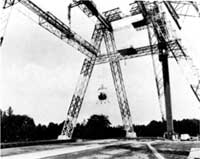 Lunar landing research facility, 1965 |
|
Rendezvous Docking Simulator, Langley Research Center The docking simulator (common name--real-time dynamic simulator) is the only surviving trainer that Gemini and Apollo astronauts used to practice rendezvous and docking techniques needed to link two vehicles in space. The mastery of this skill was critical to the success of the lunar orbit rendezvous technique for landing man on the moon. After completion of the Apollo program, the simulator was modified for other purposes. It is no longer used and although the basic simulator remains intact, many of the support facilities are gone. Currently, the simulator hangs from the ceiling of an active hangar facility. The site is open to organized groups, but very few people visit. There is no on-site interpretive media or information at the visitor center. |
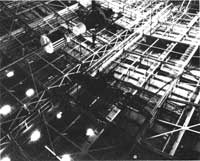 Rendezvous docking simulator before spacecraft, target, and analogue computer were removed |
|
Neutral Buoyancy Space Simulator, Marshall Space Flight Center The Army built the space simulator in 1955, and until an additional facility was built at the Johnson Space Flight Center in the mid-1970s, this was the only test facility that allowed astronauts to become familiar with the dynamics of body motion under weightless conditions. Because of its capability to support research and testing of the operational techniques and materials needed to successfully perform manned space missions, the simulator contributed significantly to the American space program, especially Projects Gemini and Apollo. The simulator is still active; however, few modifications have occurred over the years, and it retains a high degree of integrity. It is interpreted on bus tours by a driver/tour guide, but the narrative program does not clearly describe the simulator's role in the early American space program. There is little interpretive media on the simulator at the Alabama Space and Rocket Center. Approximately 130,000 visitors toured the facility in 1986. |
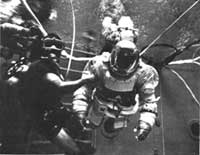 Neutral buoyancy space simulator, 1972 |
| HARDWARE TEST FACILITY |
This site illustrates the Johnson Space Center's role in the testing necessary to ensure that astronaut equipment would operate safely in space and on the moon.
|
Space Environment Simulation Laboratory, Johnson Space Center Built in 1965, this laboratory (common name--space environment simulator laboratory) man-rated and tested the integrity of the Apollo command module, service module, lunar module, hardware, and space suits under simulated space conditions. This testing was essential to the safety and well being of the astronauts. The laboratory retains a high degree of integrity and is still in use. It receives a fair number of visitors in organized groups only. There is limited interpretive media on the site and none at the Johnson visitor center. |
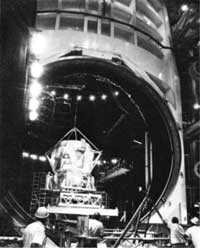 Space environment simulation laboratory, chamber A, 1971 |
| UNMANNED SPACECRAFT TEST FACILITIES |
The following sites illustrate the extensive ground support testing needed for the American unmanned space program--the exploration of near and deep space. Both of these sites have contributed to the success of the unmanned space program and represent the technological sophistication necessary to accomplish that program.
|
Spacecraft Magnetic Test Facility, Goddard Space Flight Center Built in 1966, this facility (historic name--attitude control test facility) is the only one of its kind in NASA's inventory. It determines and minimizes the magnetic movements of even the largest unmanned spacecraft and thereby eliminates unwanted torque resulting from the interaction of the spacecraft with the earth's magnetic field. The use and operation of this facility was and continues to be essential to the success of the American space program. This test facility is currently being used, its structure and equipment are essentially intact, and it retains a high degree of integrity. It is several miles from the Goddard visitor center and main complex. It receives little visitor use and may be toured only in organized groups. Interpretive media includes informational signs and photographs at the entrance; they do not discuss the facility's importance to the Man in Space theme. There is no interpretive media about the facility at the Goddard visitor center. |
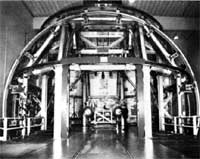 Spacecraft magnetic test facility, 1971 |
|
Twenty-Five-Foot Space Simulator, Jet Propulsion Laboratory The simulator was built in 1961 and is the only NASA facility capable of simulating true interplanetary conditions. Its test chamber can accommodate most modern spacecraft. In 1966 it was the first system of its type to use a collimating mirror to produce the intense solar radiation of space. The simulator is still in active use; however, over the years only minor modifications have been made, and it retains a high degree of integrity. Few visitors, in organized groups only, have an opportunity to tour this site. Interpretive media includes informational signs and historic photographs of the simulator; they do not indicate the significance of this site. There is no visitor center at the Jet Propulsion Laboratory. |
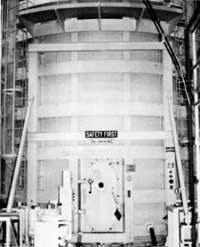 Twenty-five foot space simulator, 1986 |
 Top
Top
Last Modified: Wed, Nov 29 2000 10:00:00 am PDT
http://www.cr.nps.gov/history/online_books/butowsky3/space2d.htm
![]()

